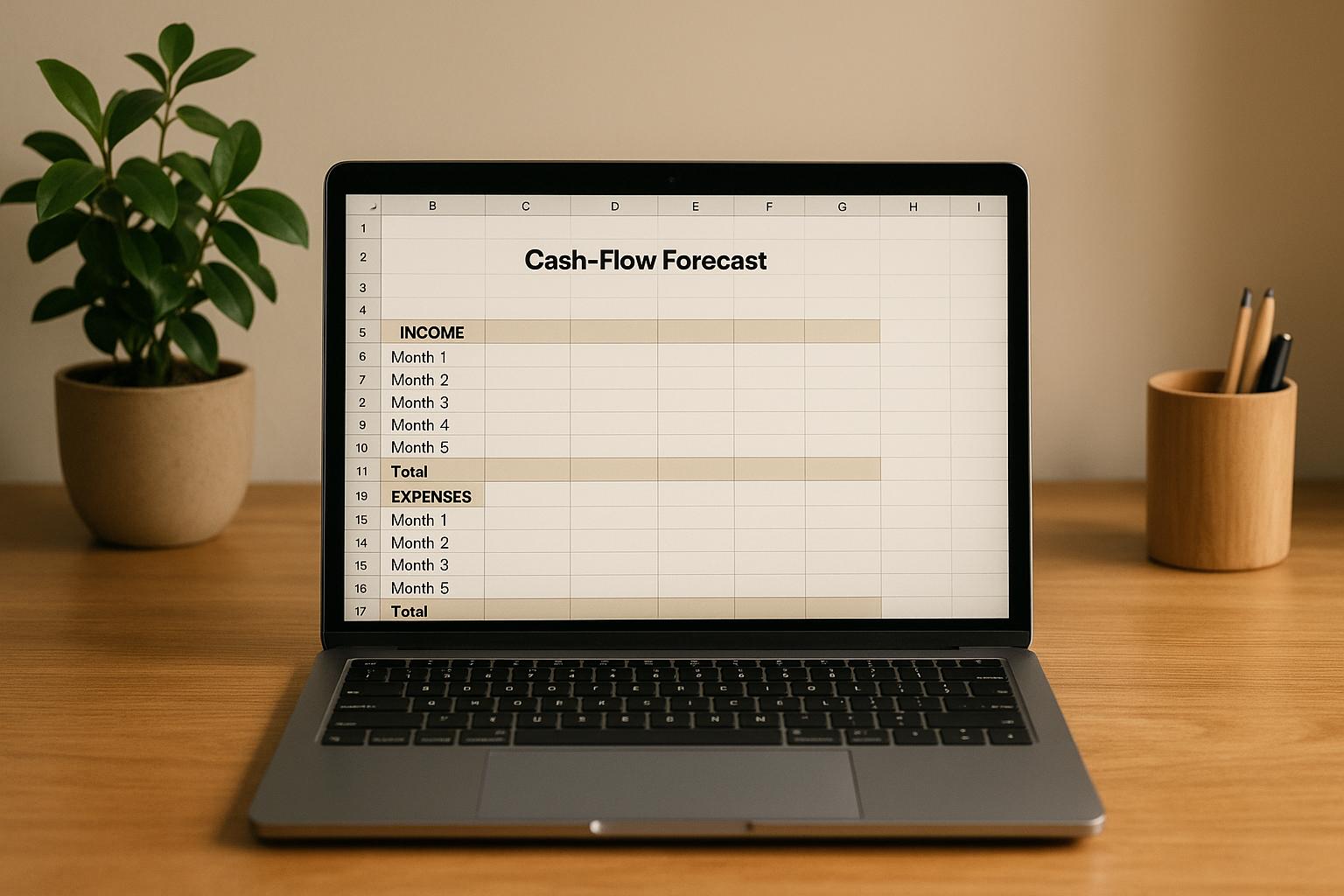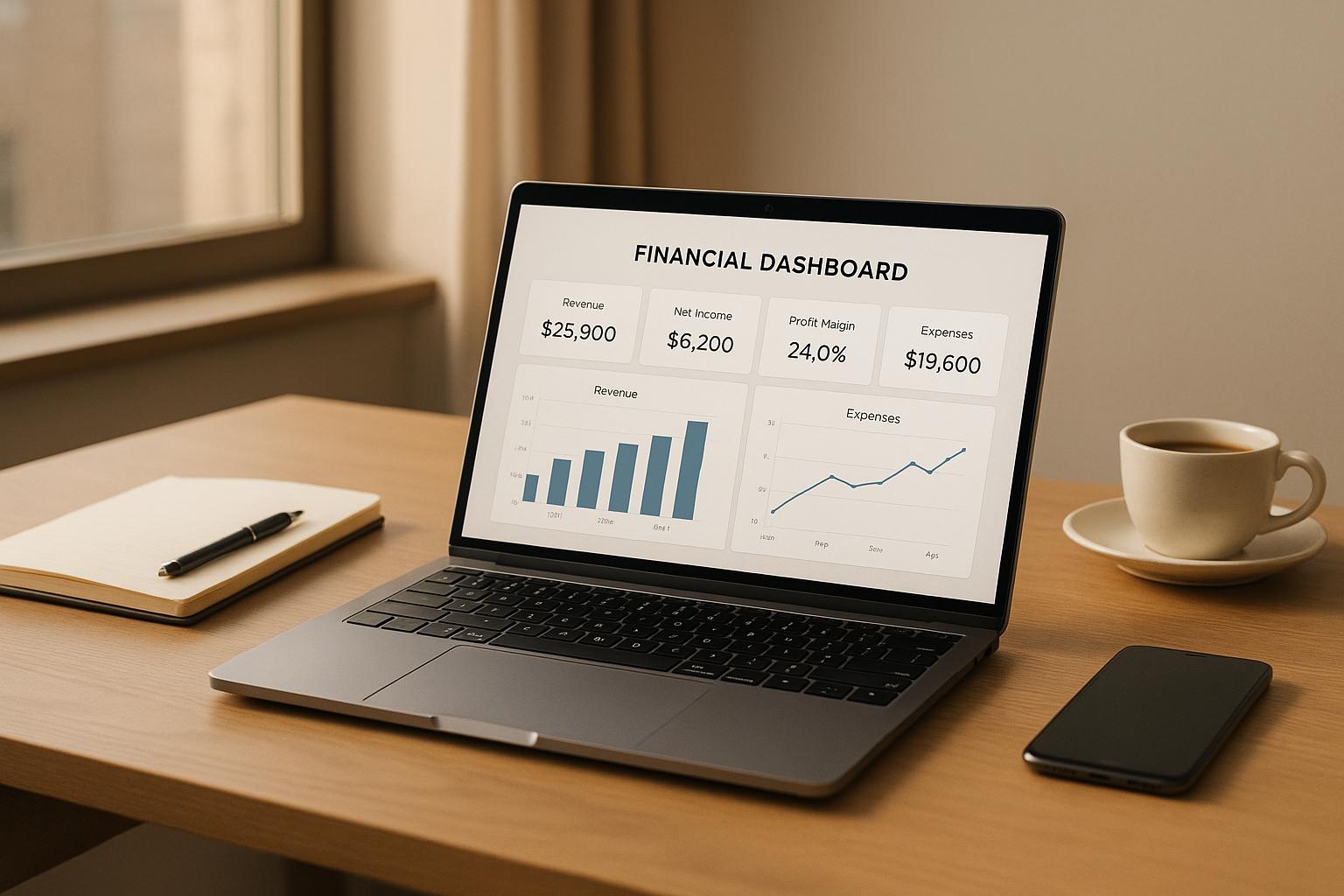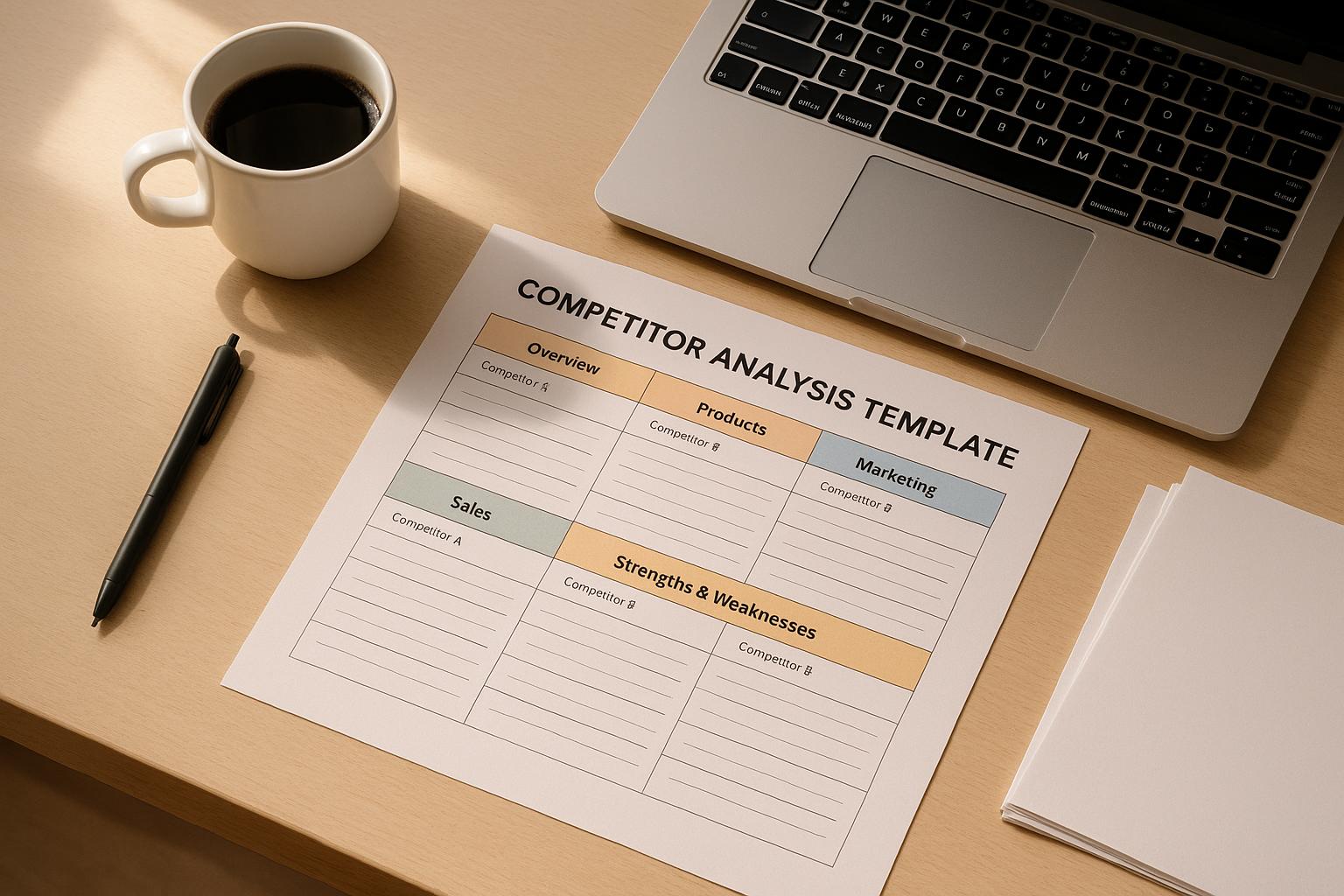
Cash-flow forecasting helps you track when money enters and leaves your business, ensuring you're prepared for upcoming expenses and avoiding cash shortages. For small businesses, it’s essential to plan ahead, especially with seasonal fluctuations or delayed customer payments. A basic spreadsheet is an easy way to start, offering flexibility and transparency without complex tools or extra costs.
Here’s how to create a simple cash-flow forecast:
- Track inflows and outflows: List all income sources (e.g., customer payments) and expenses (e.g., rent, payroll) based on when they actually occur.
- Calculate balances: Start with your current cash balance, then add inflows and subtract outflows to project your ending balance for each period.
- Spot trends: Use the forecast to identify patterns, prepare for slow periods, and manage unexpected costs.
With regular updates, your forecast becomes a reliable tool for making informed financial decisions. Start with a downloadable template, customize it to fit your business, and update it weekly or monthly to stay on top of your finances.
Create a Cash Flow Forecast for Your Business (in under 16 minutes) {FREE TEMPLATE}
Key Parts of a Simple Cash-Flow Spreadsheet
A cash-flow spreadsheet doesn’t have to be complicated to be effective. In fact, the best ones focus on just three essential components. Together, these elements provide a clear snapshot of your business’s financial health. Understanding these parts will help you create a tool that truly supports your business operations.
Basic Inputs: Money Coming In and Going Out
At its core, a cash-flow forecast revolves around two key categories: cash inflows and cash outflows. These are the building blocks for every calculation in your spreadsheet, so getting them right is critical.
- Cash inflows are all the funds entering your business. These might include customer payments, loans, investments, or any other income. For example, a consulting business might track retainer payments, project completion bonuses, or contract renewals. Timing is everything when recording inflows. If you send an invoice in January but the client pays 45 days later, that payment belongs in March, not January. This timing difference is what sets cash-flow forecasting apart from profit-and-loss accounting - it reflects when cash actually moves, not just when it’s earned or owed.
- Cash outflows cover your business expenses. These range from fixed costs like rent and insurance to variable ones like inventory or marketing. It’s helpful to categorize expenses in a way that mirrors your actual spending. Common categories include payroll, rent, utilities, inventory, marketing, loan payments, and equipment. Don’t overlook periodic expenses like quarterly taxes, annual insurance premiums, or seasonal costs. For instance, a landscaping business might spend heavily on equipment in the spring, while a retail store might see a spike in inventory purchases before the holidays.
Once you’ve nailed down your inflows and outflows, the next step is to calculate your cash position over time.
Starting and Ending Cash Balances
Your starting cash balance is the foundation of your forecast. It represents the actual cash you have on hand at the beginning of a period. This number needs to be accurate because every subsequent calculation depends on it. Be sure to account for any outstanding checks or deposits that haven’t cleared yet.
At the end of each period, your ending cash balance shows how much cash you’ll have left after factoring in all inflows and outflows. This balance then becomes the starting point for the next period, creating a continuous view of your financial standing. Keeping an eye on these balances can help you spot potential cash shortages well in advance.
Most businesses track these balances monthly. However, during busy seasons or tight cash situations, you might need to switch to weekly - or even daily - tracking. For example, a seasonal business could monitor daily balances during peak times and return to monthly updates during slower periods.
Net Cash Flow Calculation
Net cash flow is the difference between your total cash inflows and outflows for a given period. It’s a straightforward calculation: Total Cash Inflows - Total Cash Outflows. This number tells you whether you’re building up cash reserves or spending more than you’re bringing in.
When you combine your net cash flow with your starting cash balance, you get your ending cash balance for the period. The formula looks like this:
Ending Cash Balance = Starting Cash Balance + Net Cash Flow
Tracking your net cash flow over time reveals trends that can guide your decisions. For instance, consistent positive cash flow indicates healthy operations and potential for growth. On the other hand, sustained negative cash flow signals trouble and might require action - whether that’s increasing income, cutting expenses, or seeking additional funding.
Step-by-Step Guide to Building Your Cash-Flow Forecast
Ready to create a cash-flow forecast that fits your business? Let’s walk through the process step by step. By the end, you’ll have a clear and functional tool to manage your finances.
Setting Up Your Spreadsheet
Start by opening a new spreadsheet and laying out the structure. In the first row, create column headers for your time periods. Use the MM/DD/YYYY format for dates, such as 01/01/2025, 02/01/2025, and 03/01/2025. Depending on your needs, you can set these periods to track weekly (for tighter control) or monthly (for broader oversight).
Next, format your currency cells to display U.S. dollars. Select the cells where you’ll enter monetary values, then apply the $ symbol with two decimal places. This makes your numbers clearer and avoids misunderstandings.
Now, move to the rows on the left side of your spreadsheet. Label them with your main cash categories. Start with "Starting Cash Balance" at the top. Below that, list your cash inflow categories, such as "Customer Payments," "Loan Proceeds," or "Investment Income." Follow this with your cash outflow categories like "Payroll," "Rent," "Utilities," "Marketing," and "Loan Payments." Finally, add rows for "Total Cash Inflows," "Total Cash Outflows," "Net Cash Flow," and "Ending Cash Balance."
With this framework ready, you’re set to input your financial data.
Adding Your Financial Data
Begin by entering your actual starting cash balance in the first period. This should reflect the current balance in your bank account, minus any pending checks that haven’t cleared. Accuracy here is essential since every calculation builds on this number.
Next, add your expected cash inflows for each period. Record when you’ll actually receive the money, not when it’s earned. For instance, if you invoice a client in January but they typically pay 45 days later, assign that payment to the appropriate future period. Use historical data and customer payment trends to make realistic projections. If you’re new to forecasting, research industry norms or consult experienced business owners for guidance.
Then, input your cash outflows, including both regular and occasional expenses. Cover recurring costs like rent and payroll, but don’t forget periodic expenses like quarterly tax payments, annual insurance premiums, or seasonal costs.
Once your data is in place, it’s time to set up automatic calculations to save time and reduce errors.
Setting Up Automatic Calculations
Use the SUM function to calculate totals for each category. For example, if your cash inflow entries for January are in cells B7 through B10, your formula will be =SUM(B7:B10). Do the same for your cash outflows and copy these formulas across all time periods.
To calculate your net cash flow, subtract your total outflows from your total inflows. For instance, if total inflows are in row 15 and total outflows in row 25, your formula for January would be =B15-B25.
For the ending cash balance, use this formula: Ending Balance = Starting Balance + Cash Inflows – Cash Outflows. In the first period, add your starting cash balance to your net cash flow. For subsequent periods, link the starting balance to the previous period’s ending balance. For example, if January’s ending balance is in cell B30, February’s starting balance formula would be =B30. Copy this formula across all periods to ensure continuity.
Finally, test your formulas with sample data. Change an income or expense figure and confirm that all related totals update correctly. This step ensures your forecast is functioning properly. For added accuracy, create a validation row using SUM and IF formulas to double-check that totals align with detailed entries. This internal check acts as a safety net, catching errors before they grow into bigger issues.
sbb-itb-08dd11e
Download Template and Customization Tips
Getting the Template
Kickstart your cash-flow forecasting with ready-made templates designed for both Excel and Google Sheets, complete with U.S. currency symbols and MM/DD/YYYY date formats. These templates are easy to access - just click the "Download Now" buttons or follow direct links on provider websites. Some may ask for an email sign-up, while others allow immediate downloads. Most templates are in .xlsx format for Excel, and many also include direct links for editing in Google Sheets.
Look for templates that cater to varying time horizons, offering worksheets for daily, monthly, quarterly, and yearly tracking - all in one file. This flexibility lets you switch between different forecasting periods as your business evolves. Plus, these templates are ready to use right away, with no need for installation or enabling macros. Just download and start entering your data.
Adjusting Categories and Time Periods
Once you’ve got your template, tweak it to reflect your business’s unique operations. Start by replacing generic categories with ones that better match your cash flow.
For cash inflows, you might swap default entries for more specific revenue sources like "Customer Payments", "Subscription Renewals", "Consulting Fees", or "Product Sales." On the cash outflows side, consider adding categories such as "Marketing Spend", "Software Subscriptions", "Equipment Purchases", or "Professional Services."
To make these adjustments:
- Replace the template’s existing row headers with your own income and expense types.
- Add new rows for additional categories, copying formulas from existing rows.
- Update SUM formulas to include any new rows you’ve added.
You can also customize the time intervals to suit your business cycles. For example, if you operate on a weekly cash flow cycle, change the column headers from months to weeks. Seasonal businesses might prefer extending their forecasts to cover 12 or 18 months to capture full cycles.
For a more structured approach, organize your cash flow into three main sections:
- Operating activities: Day-to-day operations like sales and expenses.
- Investing activities: Asset purchases or sales.
- Financing activities: Loans, investments, or debt payments.
This setup isn’t just practical - it also makes your forecast more useful for financial analysis and reporting.
Formatting Tips for Easy Reading
A well-formatted forecast makes all the difference when it comes to clarity and usability. Start by applying consistent currency formatting throughout your spreadsheet. Then, use color coding to make data easier to interpret:
- Green for cash inflows.
- Red for cash outflows.
- Blue for summary calculations like "Net Cash Flow" and "Ending Cash Balance."
To keep things tidy, add extra spacing between major sections. For example, insert blank rows between inflows and outflows or between detailed entries and summary totals. This not only improves readability but also minimizes the risk of data entry errors.
For larger spreadsheets, freeze the top row and first column so headers stay visible as you scroll. This is especially handy when working with forecasts that span multiple time periods or categories.
If you’re considering multiple financial scenarios, create separate worksheets within the same file for each one. Clearly label these tabs with names like "Conservative", "Optimistic", or "Most Likely" to streamline analysis and planning discussions. This way, you can easily compare outcomes and make informed decisions.
Using Your Cash-Flow Forecast for Better Business Decisions
Spotting Patterns and Planning Ahead
Your cash-flow forecast is more than just numbers - it's a roadmap that helps you spot trends and prepare for what’s ahead. For example, do your sales spike in December but drop off in February? Do expenses climb during the summer months? Recognizing these patterns allows you to plan for slower periods and make the most of busier seasons.
Keep a close eye on your ending cash balance. If it’s approaching $5,000, it’s time to act. This might mean securing a line of credit, postponing non-essential purchases, or ramping up sales efforts to avoid potential cash crunches.
Your forecast also helps ensure you have enough cash to cover planned expenses. Thinking about purchasing new equipment? Check your forecast for months where your ending balance can handle the cost without disrupting operations.
Pay attention to your net cash flow, too. It shows you which months are adding to your reserves and which are draining them. If you’re consistently seeing negative cash flow, it’s a red flag for deeper issues that need fixing. On the other hand, a steady buildup of positive cash flow might be the green light you need to invest in growth - like expanding your offerings, launching a new marketing campaign, or developing a new product.
The key? Regular updates to keep your forecast accurate and actionable.
Keeping Your Forecast Current
Once you’ve identified trends, keeping your forecast up to date is essential. Update it weekly with real cash inflows and outflows. If your projections don’t match reality - say you expected $12,000 in sales but brought in $9,500 - adjust your forecast and refine the numbers for the months ahead.
Monthly reviews are just as important. Compare your current data with past forecasts to spot recurring overestimations or underestimations. If certain expenses are consistently higher than you planned, revise your projections to reflect the actual costs. Jot down notes about unexpected events, like late client payments or surprise expenses, to better prepare for similar situations in the future.
Revisit the assumptions behind your forecasts regularly. For instance, if you’ve been estimating sales based on moving 100 units a month but consistently sell only 75, it’s time to adjust your expectations. A well-maintained and realistic forecast is your best tool for making sound financial decisions.
Improving Forecasts with IdeaFloat

While spreadsheets are great for basic cash-flow tracking, IdeaFloat takes forecasting to the next level by offering tools that refine expense tracking, improve pricing strategies, and integrate data into professional financial documents.
With IdeaFloat’s advanced pricing research tools, you can enhance your revenue projections by analyzing competitor pricing and market trends. This kind of data-driven insight can directly improve the accuracy of your sales estimates.
The Financial Model feature provides a deeper look at your business’s finances, detailing profitability, margins, and long-term stability. This broader view helps you evaluate whether your cash flow supports a sustainable operation.
When it’s time to share your financial data with investors or lenders, IdeaFloat’s Business Plan Generator can transform your spreadsheet into polished, professional documents. These tools offer a complete picture of your company’s financial health and strategy, giving you the confidence to make informed, timely decisions. By integrating these insights, you’ll be better equipped to steer your business toward success.
Getting Started with Your Cash-Flow Forecast
Creating a cash-flow forecast doesn’t have to be complicated. Using a simple spreadsheet, you can take charge of your business finances and map out a clear financial plan. This step sets you up with the tools to build a dependable roadmap for your business’s future.
To begin, download the provided template and customize it to reflect your specific cash flow. Adjust it to match your income and expense patterns, ensuring it aligns with the unique movements of your business.
Keep your forecast practical by scheduling regular updates. For newer businesses or those managing tight cash flow, weekly updates can help you catch potential problems early. As your business grows and stabilizes, monthly updates may provide a better balance between detail and simplicity.
Choose a forecasting period that fits your business cycle. Many small businesses find a 12-month forecast, updated monthly, works well. This approach gives enough visibility to prepare for seasonal changes, plan for major expenses, and identify growth opportunities without overwhelming you with data.
Starting with a basic spreadsheet helps you hit the ground running. Focus on tracking your income and expenses, and as you become more comfortable, you can gradually add more details to your forecast. Remember, the quality of your forecast will improve with consistent updates.
The key is to take that first step. Download the template, input your current financial information, and begin tracking your cash flow. Starting today sets the foundation for smarter financial decisions down the road.
FAQs
How often should I update my cash-flow forecast to keep it accurate and useful for my business?
How often you should update your cash-flow forecast largely depends on how much your business's finances fluctuate. If your cash flow is steady and predictable, updating it monthly or even quarterly might be sufficient. But for businesses experiencing frequent changes or rapid growth, a weekly update can help you stay on top of the shifting numbers.
By keeping your forecast up to date, you’ll have a clearer picture of your current financial situation. This allows you to make smarter decisions and steer clear of unexpected financial hiccups. The key is to pick a schedule that works best for your business's pace and complexity.
What mistakes should I avoid when creating and managing a cash-flow forecast with a spreadsheet?
When creating and managing a cash-flow forecast, there are several missteps that can throw off your projections. Here are some to keep in mind:
- Overlooking small expenses: Those seemingly minor costs can quietly pile up and have a noticeable impact on your cash flow over time. Don’t let them slip through the cracks.
- Relying on incomplete or outdated data: A forecast is only as good as the numbers behind it. Use current, accurate financial data to avoid misleading results.
- Getting too optimistic: Overestimating income or underestimating costs can lead to forecasts that don’t match reality. Stay grounded in realistic expectations.
- Ignoring seasonal patterns: Many businesses experience periods of higher or lower revenue and expenses throughout the year. Failing to factor these in can distort your forecast.
- Neglecting regular updates: A cash-flow forecast isn’t a one-and-done task. It needs to be updated frequently to reflect changes in your business environment or market conditions.
By steering clear of these common errors, you'll be better equipped to create a forecast that provides a clear, actionable picture of your business's financial health.
How can I tailor a cash-flow forecast spreadsheet to meet my business's unique needs?
To make a cash-flow forecast spreadsheet work for your business, start by tweaking the time intervals to fit your needs - whether that’s tracking daily, weekly, or monthly. Then, set a time frame that matches your goals, such as a 3-month, 6-month, or even a full-year forecast. Lastly, adjust the categories for cash inflows and outflows to reflect your business activities. This might include things like sales revenue, operating costs, or other income streams.
By customizing these elements, you’ll create a forecast that delivers clearer and more practical insights for managing your cash flow.
Related Blog Posts
Get the newest tips and tricks of starting your business!


